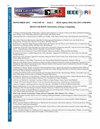An Isolation Transformer-less Single DC Source fed Dual 5-leg Inverter Controlled 5-Phase Induction Motor with Modified Direct Torque Control
IF 1.3
4区 工程技术
Q3 COMPUTER SCIENCE, INFORMATION SYSTEMS
引用次数: 0
Abstract
A modified hysteresis torque controller is introduced into the direct torque control scheme of a 5-phase open-end winding induction motor, aimed at enhancing steady-state performance by minimizing torque, flux ripple, and current total harmonic distortion (%THD) with the dual 5-leg inverter configuration. The proposed Direct Torque Control (DTC) strategy utilizes a common DC source for both converters without the need for a bulky isolation transformer, accomplished by nullifying common mode voltage in the dual inverter open-end winding configuration. This proposed technique employs 30 virtual voltage vectors (VVVs) generated from the dual inverter configuration, strategically categorized as small, large, and medium voltage vectors. These 30 VVVs are instrumental in forming a 7-level torque controller and a 3-level torque controller in the proposed DTC scheme. In contrast to the existing DTC method, which uses 20 virtual voltage vectors from a dual 5-leg inverter configuration and grapples with challenges like high current harmonic distortion, torque ripple, and flux ripple, the proposed control scheme introduces a new 7-level torque hysteresis controller. The outcome is reduced torque and flux ripple, along with minimized harmonic content across various speeds and loading conditions without disturbing the dynamics. Experimental hardware results are scrutinized, comparing the classical DTC with the proposed DTC schemes in open-end winding induction motors, aiming to know the superior qualities of the proposed control approach.采用改进型直接转矩控制的无隔离变压器单直流电源馈电双 5 脚逆变器控制 5 相感应电机
在五相开口绕组感应电机的直接转矩控制方案中引入了一种改进的磁滞转矩控制器,旨在通过最大限度地降低双五脚逆变器配置的转矩、磁通纹波和电流总谐波失真(%THD)来提高稳态性能。所提出的直接转矩控制(DTC)策略利用两个变流器的共用直流源,无需笨重的隔离变压器,通过消除双变频器开口绕组配置中的共模电压来实现。这项建议的技术采用了双逆变器配置产生的 30 个虚拟电压矢量 (VVV),战略性地分为小型、大型和中型电压矢量。这 30 个虚拟电压矢量有助于在拟议的 DTC 方案中形成 7 级转矩控制器和 3 级转矩控制器。现有的 DTC 方法使用双 5 脚逆变器配置中的 20 个虚拟电压矢量,需要应对高电流谐波畸变、转矩纹波和磁通纹波等挑战。其结果是降低了扭矩和磁通纹波,同时在各种速度和负载条件下将谐波含量降至最低,而不会干扰动态特性。对实验硬件结果进行了仔细研究,比较了开式绕组感应电机中的经典 DTC 与所提出的 DTC 方案,旨在了解所提出的控制方法的优越性。
本文章由计算机程序翻译,如有差异,请以英文原文为准。
求助全文
约1分钟内获得全文
求助全文
来源期刊

IEEE Latin America Transactions
COMPUTER SCIENCE, INFORMATION SYSTEMS-ENGINEERING, ELECTRICAL & ELECTRONIC
CiteScore
3.50
自引率
7.70%
发文量
192
审稿时长
3-8 weeks
期刊介绍:
IEEE Latin America Transactions (IEEE LATAM) is an interdisciplinary journal focused on the dissemination of original and quality research papers / review articles in Spanish and Portuguese of emerging topics in three main areas: Computing, Electric Energy and Electronics. Some of the sub-areas of the journal are, but not limited to: Automatic control, communications, instrumentation, artificial intelligence, power and industrial electronics, fault diagnosis and detection, transportation electrification, internet of things, electrical machines, circuits and systems, biomedicine and biomedical / haptic applications, secure communications, robotics, sensors and actuators, computer networks, smart grids, among others.
 求助内容:
求助内容: 应助结果提醒方式:
应助结果提醒方式:


